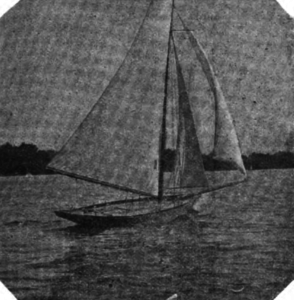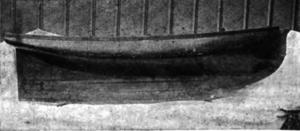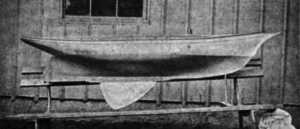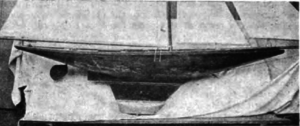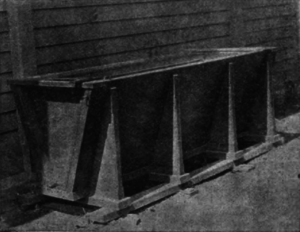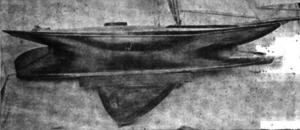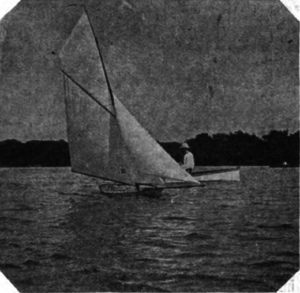Model Yachting about New York
by Frank Nichols, American Model Yacht Club
So much pleasure may be derived from the construction and sailing of model yachts, and so much practical information as well, that it is strange that the sport has not grown more rapidly in the twenty odd years since it first became known around New York. In England there are many clubs, and although good water for this purpose is not always easy to find, the sport has received the attention which it deserves and from those mainly interested in large yachts. The facilities for obtaining all necessary materials and fittings are far greater than in this country, and the sport receives much support from the monthly paper, The Model Yachtsman and Canoeist, published at Hull.
On Independence Day, 1872, model yachting was initiated on the large lake in Prospect Park, Brooklyn, Long Island, by an organization known as the Prospect Park Yacht Club, with the following officers: Com., James Flemming; Vice-Com. Geo Sherwin; Pres., Sam. Avila; Sec., John H. Fisher; Treas., Jos. Peto; Meas., Henry Heitman. Yachts, seventeen — fifteen schooners and two sloops. The yachts were measured over all for time allowance in racing.
There being a great lack of interest on the part of the Park Commissioners, little attention was shown toward model yacht racers and the accomodations for the storage of yacht models in the Park grounds were limited to a few members, while the only convenience near to the lake was that of a rickety shanty outside of the Park grounds, situated across the old Coney Island road, now avenue. Those who were less fortunate in securing storage for their craft in either of these places were obliged, after a day’s sport, to carry these yachts to the [street] cars, or, as in some cases, those who lived but a short distance from the park conveyed thier models to their homes on improvised hand wagons, and trying were the toils of conveying yachts to their respective store-houses, as the number of [street] cars goint to and from Prospect Park was very small. As some of these models were very valuable, great anxiety was felt on the part of their owners as to their security; nevertheless under such adverse circumstances the sport was greatly enjoyed.
Such a condition of things continued until the year 1876, when a united effort was made to obtain better accomodations near the lake, the outcome of which event resulted in securing the out-house belonging to the pumping station, which is located about 200 ft. from the margin of the lake, which exchange was indeed very agreeable. But even this state of things was doomed to be disturbed by various causes, which led to the decline of the sport, as local jealousies evoked by kindred yachtsmen soon led to the organization of several yacht clubs, each of which were striving to outrival their opponents, and all aiming to impress the Park Commissioners with the idea that they alone were the original and bona fide club.
It has been well said that “In union there is strength,” and it was demonstrated that the divided influence thus brought to bear up the Park Commissioners did not accomplish the desired effect, viz.: the erection of a building suitably arranged and situated upon or near the lake for the storage of model yachts.
At this time, 1876, there were in existence three yacht clubs, the Prospect Park, which was the parent yacht club; the Long Island and the American Y.C. (not the present American Model Y.C.) all of which clubs were striving for recognition by the Park Commissioners to such a degree as to prove detrimental to yachtsmen, since the Commissioners, who were at one time favorably disposed to the participants in this enterprise, became disgusted and concluded that there should not be built any house for the storage of model yachts.
Aside from those who were immediately engaged in this sport, but few persons were interested sufficiently to investigate it; not even the reporter, who is always ready to grasp any new ideas and adventures and promulgate them to the public, seemed at all inclined to touch upon this subject. The Times and World were the only daily papers which finally brought the sport to the attention of the public; and the Mercury, a weekly paper, occasionally rendered service in this direction, but aside from these papers others would comment upon it as child’s play and thus from time to time ridicule it. Those engaged in its practice were frequently called cranks, and the spectators idiots, and perhaps in some instances this term was well applied to the latter because of their nonsensical suggestions to the model yacht experts.
This condition of things existed for a short time only, when some of the members, headed by the Bros. Dayton, of the different yacht clubs, decided to make Gowanus Bay, in South Brooklyn, the rendezvous for the further continuance of investigations regarding the theories connected with the science of model yachting. Gowanus Bay in those days was a very fine spot for such a purpose, but in recent years it has become the receptacle of the city’s debris, and by this means the greater part of the once beautiful bay has become obliterated.
Permission was granted to the Manhattan Club to sail their model yachts on the large lake at the northeast section of Central Park, New York, but after a thorough test this lake was provent to be worthless for the purpose of sailing model yachts, on account of the interception of the winds by reason of the topography of the surroundings; massive trees and its south and west shores by very high grounds; hence the Manhattan Club abandoned this lake and located themselves at the foot of East 110th street and East River, New York, where storage for their yachts was obtained.
Launching their model yachts from this point they sailed through Little Hell Gate, or by way of the Kills, the intricacies of which are probably understood by our readers, to Bowery Bay, where some very fine sailing was obtained and close contests ensued. This club finally disbanded, and two of its members joined the present American Model Yacht Club.
During the years 1880 to 1887 the interest which was shown in model yachting was wavering; there was much sailing, but few new yachts were either designed or constructed.
The leading yacht club of the day was the American Model Yacht Club (this club at present holds a position similar to the N.Y.Y.C. in yachting). It was founded in 1876 and reorganized on Sept. 2, 1887. Prominent yachtsmen were elected as officers: Geo. W. Lyon, Com.; W.V. Hanson, Pres.; G.W. Townley, Treas.; J. Alvah Scott, Sec’y. and Meas. The club at that time had 17 models, which were classified according to their length on the l.w.l. into first class, embracing those 53 to 63 in.; 2nd class 42 to 53 in., and 3rd class those 30 to 42 in. in length; the rule applied for a time allowance being l.w.l., whereas the present rule embraces bith sail area and l.w.l. [Nichols assumes the reader is familiar with the general subject of skiff sailing, in which boats race the same course at the same time, but are actually racing against the clock. The “time allowance” he mentions is a form of handicap. There was also a time penalty for each instance of a skipper touching his boat to trim or adjust steering. – Ed.]
The election of a new board of officers in 1892-3, brought about a change, viz.: W.V. Hanson, Com.; Geo. W. Lyon, Vice-Com.; Geo. W. Townley, Treas.; Harry Melvin, Sec’y.; Frank Nichols, Meas., and new boats were added at this time, making 45 yachts in commission.
The large lake at Prospect Park, situated at the southwest end, and which is exposed to the strong west and southwest winds from the Atlantic, has an area of about 200,000 sq. ft. (the only drawback being the trees and shrubbery which have grown since the early days), a desirable place for model yachting; and the out-house, as stated above, being located about 200 ft. from the margin of the lake, affords facilities far superior that of any inland waters in the immediate vicinity of New York City or Brooklyn. At certain directions of the wind — say south by west, a course to windward of seven-sixteenth of a mile can be obtained, but the majority of the races are over a course of three-tenths of a mile.
The rapid growth, however, in the membership of the American Model Yacht Club has urged the necessity of more commodious storage. Model yachtsmen are at present engaged in testing the rule now employed as described above. [Handicapping by a combination of sail area and length – Ed.] There are a few opponents of the rule, but some such rule is necessary since with the old rule of l.w.l. alone there were produced big, unweildy, and heavy displacement boats carrying enormous sails, which if reproduced on a large scale would be undesireable as to handling and the possibility of losing their spars.
The changes that have taken place during the interval of 22 years are very clearly shown in the accompanying illustrations:
No. 1 represents one of the old timers of 1872-76, with short stumpy overhang, the result of the length over all measurement for time allowance at that time in vogue. This model was rigged as a schooner in one sense and a sloop in another, her fore and main masts being stepped very close together, in fact only an apology for a foresail being possible, the mainsail predominating.
The mast, sails, and rigging of this model have long since been lost or destroyed. A great number of models of that time were “dug out” from the solid block, as was this one. The dimensions are length over all 62 in., l.w.l. 59 in., beam 16 in., draft 12 in., with lead keel.
Model No. 2 was of the 1878 order of stumpy class, but was lengthened as shown in 1889, showing very fine lines; a great improvement over previous keel boats. It subsequently received the lead centerboard, which eventually became quite a fad, and did seem to improve the sailing qualities of all boats fitted with it. The dimensions were length over all 78 in., l.w.l. 60 in., beam 21 in., draft 16 in., construction, oak frames and floors, oak stem, keel and sternpost, planking of cedar 3/16 in., deck white pine, crowned very much, for no known reson.
No. 3 shows a wonderful stride, as can readily be seen, a departure from the theories of hollow waterlines, this model having full waterlines, yet showing remarkable speed; in fact with no equal in her class. She was designed and built in 1892, making her first appearance in 1893, carrying all before her. Her ballast is in the form of a bulb at the lowest edge of a brass fin, giving her great stiffness. Her dimensions are: Over all, 81 in., l.w.l., 52.9 in., beam 15 in., draft 14 in. Construction, stem, keel, and sternpost of cedar, frame of white holly bent to shape, planking Spanish cedar and deck, white pine. The illustration at the head of this article shows one of the modern model yachts under sail, from which an idea of the rig can be obtained.
The mode of measuring yachts employed by the American Model Y. C. necessitates the use of a large tank.
A straight edge is fastened across one end of the tank, acting as a stop for the after end of the l.w.l. as the yacht floats in the tank. A long rule divided into inches and tenths is attached to the top of one of the sides at right angles to the straight edge; then a T square is applied and slid along the rule until it comes in contact with the fore end of the [stem] at the l.w.l. The marking on the rule shows the length of the yacht on the l.w.l.
In conjunction with the l.w.l. the sail area also plays an important part in the measurement for time allowance. First the actual area of the sail is obtained by dividing into triangles, then the square root is extracted from the l.w.l., which sum divided by 2 gives the corrected length. The larger yacht is taxed at the rate of 10s. to the inch over a mile course, and in proportion according to the greater or lesser distance sailed. [This paragraph was clearly garbled by an editor or a typesetter. The actual rule was: square root of sail area added to LWL, the sum divided by two. – Ed.]
Strenuous attempts have been made to evade this rule, which have resulted in some odd looking models, an unusally odd one being owned by one of the members, she having been built for the second class and measuring 44 in. on the l.w.l. Her peculiarity lies in her under-water structure, where she measures at least 60 in. in length.
This yacht, however, has proven to be very fast in a breeze, but in a moderate wind she does not do so well, due to her large immersed surface. There can be no mistake as to the fact that this model is a most decided effort to cheat the existing rule.
It might be interesting to know how these models are sailed on and off the wind, one of the great difficulties to overcome. Some English model yachtsmen use weighted rudders, one for windward work and one for reaching and down the wind (in fact some owners have their pockets full of rudders of a variety of weights) thus causing loss of time in changing.
On the American model yacht a rudder (not a weighted one) is attached in the same way as on a large yacht, but with the tiller shipped aft, passing under a threaded wire which is placed across the deck just over the tiller. Then there are two nuts which travel on this wire, one on each side of the tiller, and the tiller is allowed to play between them, these nuts being used to gauge the play of the tiller when steering the yacht on a reach or down the wind. An eye is fastened to the tiller, through which a sheet is led from the main boom to a cleat fastened alongside the heel of the bowsprit; this cleat being of sufficient length to be bored with about one dozen holes, half an inch apart. A pin with an eye arrangement having the sheet attached, is placed in one of these holes and can be shifted fore and aft at pleasure.
The main sheet is led in a similar way, a snap being used on the traveler so that when about to sail on a reach or down the wind, the main sheet is cast off, and which time the other sheet before mentioned takes effect on the tiller and thus jams the rudder to leeward as far as is necessary to preserve the balance of the yacht on her course. This mode of steering has proven to be a very satisfactory one, and is universally used (with slight modifications) by all yacht owners of the American Model Yacht Club.
The advance in yacht designing is quickly followed by the model yachtsmen, and just now the fin keel is as prominent in model as in large yachts.
In handling the yachts, each owner uses a small flat bateau and a pair of oars, following or rowing beside his craft and attending to sails or rudder, or starting her on a new tack, as the course and wind requires.
Too much cannot be said in favor of model yacht sailing, as it invigorates both the body and the mind. Those indulging in this sport acquire considerable skill in handling a skiff, requiring quickness of decision in the manipulation of their yachts.
To appreciate model yachting, one must watch thoroughly the tactics required in handling a model in a close race. Appended are some of the growing clubs in the States: American Model Y.C., Brooklyn, N.Y., Philadelphia, of Pennsylvania; Connecticut, of Connecticu; Minnetonka, of Minnesota; Midget, of Boston, Mass.
Many of the old hulks of ’72 still remain in the boat house, stacked one upon the other in the loft, awaiting resurrection by their owners, who have forgotten them or have moved to unknown parts. the sight of these outbuilt and neglected old craft always brings back to the writer the recollection of many happy days spent on the lake twenty-two years ago.

